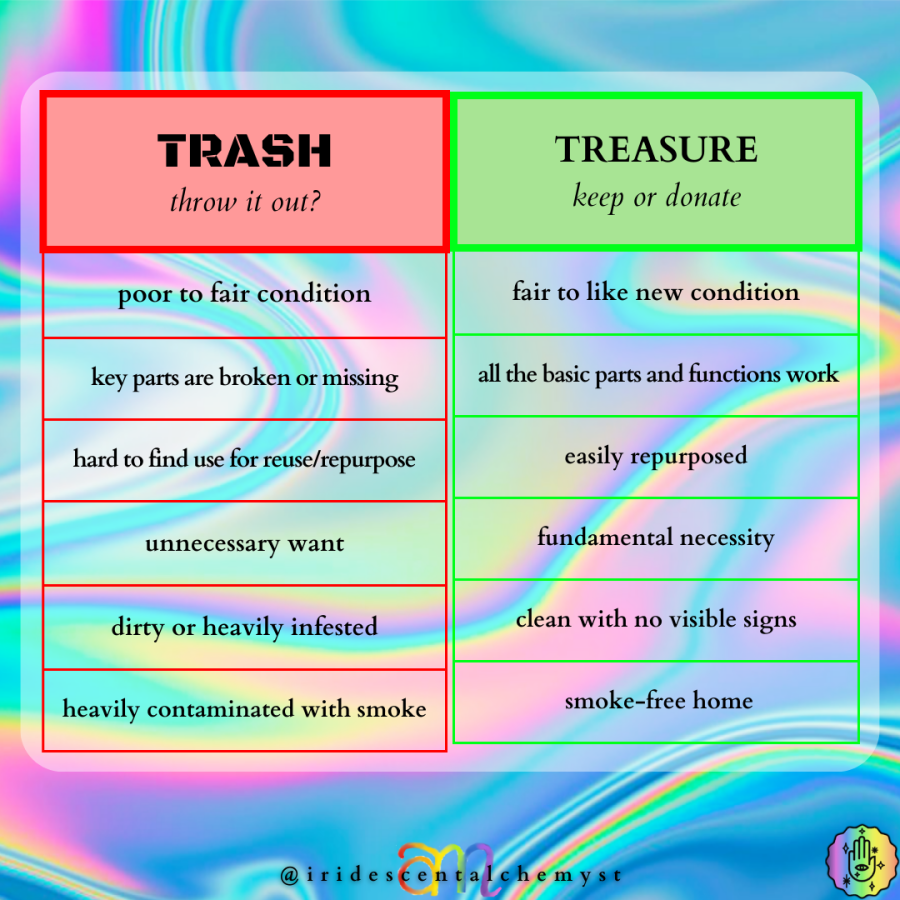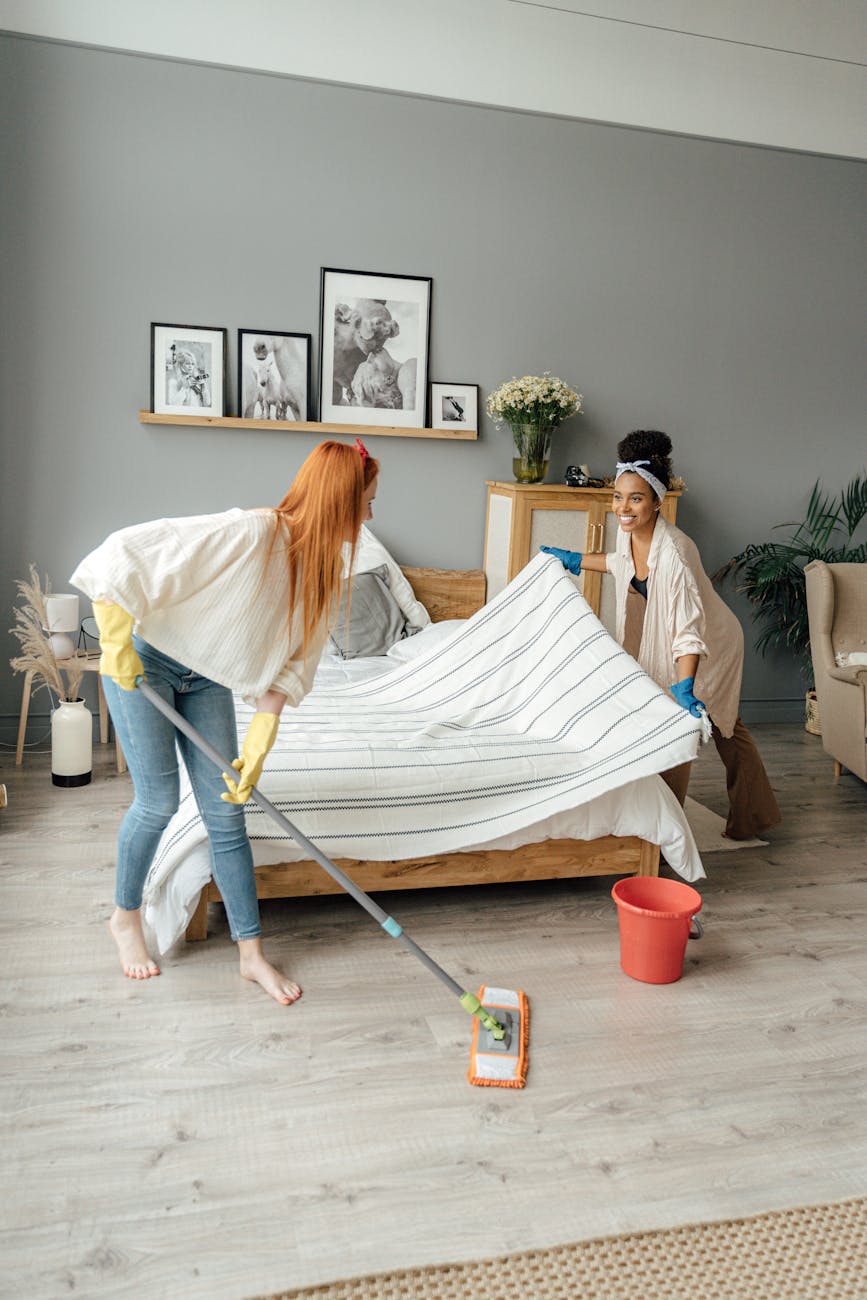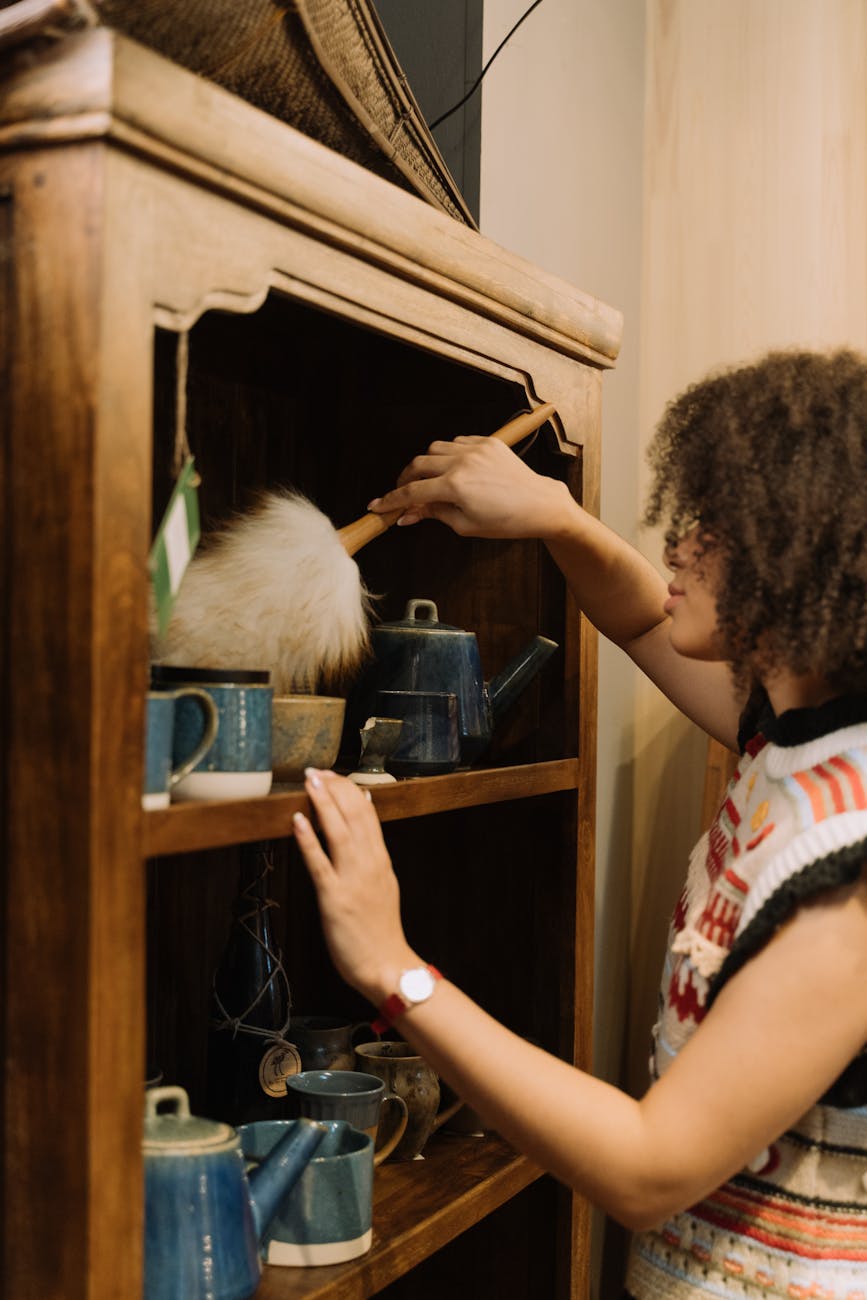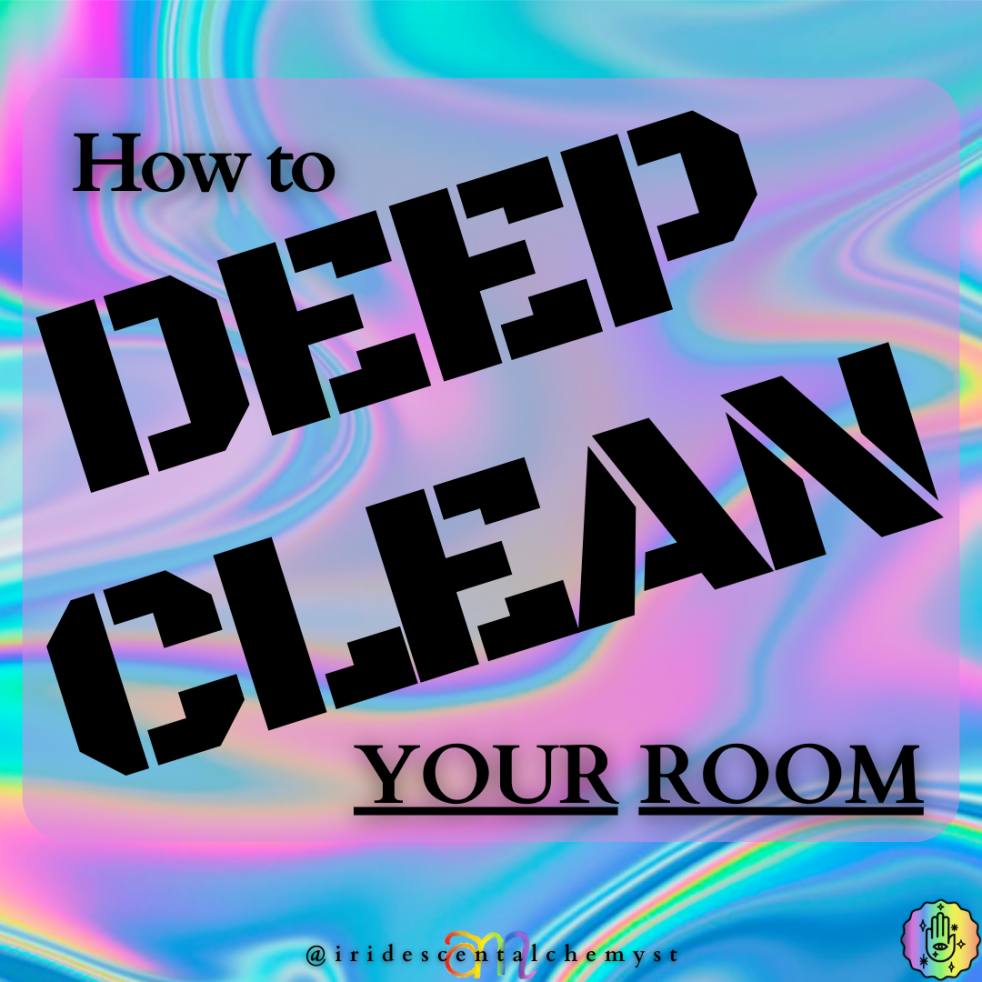We all live somewhere. Whether it’s with your parents, with a roommate, or as the head of a household, you must do your part to make sure that your space is clean. Your personal living space (bedroom) is your top priority, but as someone that uses common shared areas, you are expected to pitch in cleaning up after yourself! THIS IS NOT OPTIONAL!
Chores for Everyone
Ideally, parents help their children learn to be autonomous and responsible with chore charts that are unique for each child. Things to consider while adding household chores to a child’s workload include his or her abilities, strengths, school schedule, extracurricular activities, attitude, behavior, and specific needs. Setting up these responsibilities at a young age, and gradually increasing their responsibilities based on evidence-based and developmentally appropriate guidelines encourages children to appreciate their role in society and instill a sense of accomplishment and belonging as contributing members of the household.
I strongly advocate for Family, Child, or Teen Contracts that are easily adapted for your child and family needs. The template I have created is meant to be a tool to guide parents and caregivers through a discussion with the child to explore expectations for chores, behaviors, grades, curfew, etc. It is also especially helpful for navigating sensitive topics in a matter-of-fact way and opens the door for children to negotiate conditions for privileges or consequences related to: carrying a cell phone, driving, etc.
Why It Matters
I know that most people do not like to clean. It’s BORING, you DON’T WANT TO, and you have more important things to do… Besides, its your room, and it doesn’t bother you! Or, does it?
Can you hear your mother or father’s voice say, “Would it kill you to clean your room?” I always had a smart response, and that never helped my case. The correct answer is that no, it definitely will not kill you. You don’t have to tell your parents that they were right, but studies show that they were at least partly right. Not only does your messy room attract BUGS and MICE, evidence shows that living in cluttered chaos is literally bad for your mental and physical health!
Our brains are hardwired with a preference for order- it helps us feel safe and secure. Constant disorder increases BRAIN OVERLOAD! Cluttered home environments negatively influence your perception of your home, and human beings subconsciously link that with our overall satisfaction with life and how we view ourselves as a person. Clutter increases your anxiety level, worsens symptoms of depression and forms the foundation for hoarder tendencies and other poor coping mechanisms that get harder to overcome with time. Studies show that our working memory, ability to focus, and sleep schedule are all negatively impacted; each of these issues further worsen mental health concerns and create problems in other areas of your life as well. A chronically cluttered home can lead to a constant low-grade fight or flight response. This weakens our ability to adapt to stress overtime, increasing the risk for digestive issues, type 2 diabetes, and heart disease.
While I am thinking of it, I should mention that I have never been bothered so much by spiders. I was a tom-boy and I played with snakes when I was younger. I promise you that I am not joking one bit. My mother hated it! HA!
Bees didn’t scare me, I swatted away any wasps that came my way. Mice startle me, but that is not what gets me to jump up on a chair, screaming in horror like a little girl. What bug totally CREEEEPS me out, you ask?
House Centipedes!! EEEEEK!!! I swear these things are aliens straight from outer space! UGH!
Operation CLEAN ROOM: Your Step-By-Step Guide
Learn how to clean your bedroom- and get it done more quickly so you have time to enjoy fun and relaxing activities! These tips will help you get it done in NO TIME! And might even make it more enjoyable!
TIP: Deep clean a room each week/month so that throughout the year each room will have been thoroughly cleaned, and lightly clean regularly. This works really well to keep clutter manageable, so you don’t have to work for hours to get it done! For more tips on putting together a cleaning schedule- CLICK HERE
Few people like to clean, but it is part of life that is never done! Any task you start with a negative attitude will take much longer and you will be miserable in the process. Suck it up buttercup! Being a Debbie Downer is a waste of time and energy, so you might as well find ways to make it more fun!
This guide helps you to break a big task into smaller, more reasonable steps. I have developed these tips and tricks through trial and error throughout my life. More recently, I have been able to perfect the process after helping several friends to declutter their homes, implement a system for managing the household, and build a foundation for a better future!
Step # 1- Pre-gaming
Estimated length of time: 20-30 minutes
That’s why I called the first step “pre-gaming!” The best way to get your mind right for any task that challenges you physically, mentally, and emotionally is to: get your head into the game!
MAKE A GAME PLAN
*Will you be taking on ONE ROOM, an area in a room, or the whole house? I highly recommend limiting your focus to one room or area at a time. This helps you stay on task and makes your work more efficient. Work smarter, not harder!
*Set a time limit. Many people find that they work better with a set deadline. Sports have designated time frames, and who doesn’t love the excitement of racing against the clock as the seconds wind down!
*No better time than now to start! Delaying the inevitable is pointless really. Even if you do end up laying around or playing on your phone for awhile longer, the entire time you are building anxiety about the upcoming task. Quit making excuses. This has waited long enough! Yes, it will take some time, but the longer you wait, the longer it will take for it to be done.
PREGAME ROUTINE
*Turn up the tunes and dance! If I am feeling particularly tired or unmotivated (lazy), I turn up my favorite playlist and dance. Even on my grumpiest days, it doesn’t take long until I find myself dancing to the beat; and before I know it, I am ready to get shit done!
*Jam out! Even if you aren’t the dancing type, music is the number one way to quickly turn your frown upside down! Crank it up LOUD and let the music elevate and motivate you! I have a playlist that I put together specifically for cleaning that starts out with a few harder rock songs to help me release irritation or frustration, and gradually shifts to happier songs that keep me motivated. Find what works for you!
*Make it a habit! Once you have your space in order, and you experience the difference it makes with all your senses, you will feel motivated to keep it that way. The best tricks to maintain it are taking a few minutes each day to tidy up, and scheduling time each week to do things like laundry and taking out the trash. Chores that you don’t particularly like are much easier to manage in small doses and feel less overwhelming.
Step # 2- Gather Supplies!
Estimated length of time: 10 minutes
Having everything you need on hand will be a huge time saver! Even running to the next room to grab something can completely derail your efforts and lead you down a rabbit hole of distractions!
I use a cleaning caddy that stores all the typical cleaning items and it is handy to grab it from the cupboard when I need it. Each room in the house requires different supplies, but the following list covers basic needs for general cleaning.
- Plastic or garbage bags
- Dusters (feather dusters or cloth for wiping down surfaces/dusting)
- Damp microfiber or wash cloth
- Paper towels or cloth rags
- Window cleaner (what works best for cleaning windows? NEWSPAPER!)
- Vinegar and water (I mix 1 part vinegar with 3 parts water for a natural cleaning solution)
- Spray Bottle or Bucket (for cleaning solution, or plain water)
- Little notebook and pen (see step #8)

LIFE HACK- finally a job for those extra socks without a mate! A damp cloth is much more effective than polish and/or a feather duster at clearing and trapping the dust that hides everywhere around you.
These supplies will not fit in a caddy, obviously, but are also essential for the job.
- Laundry basket
- Trash can
- Mop and Bucket
- Vacuum
- 3 medium to large cardboard boxes (see step #6)

LIFE HACK! One last thing… grab yourself a beverage. Eat a snack or light meal before you get started if you must, but avoid a larger meal because it will fill you up, slow you down, and can make you tired. If you feel hungry, drink some water. Studies suggest that our brains often confuse thirst for hunger, and experts estimate that 75% of Americans are chronically dehydrated.
Ncbi.nlm.nih.gov/books/nbk555956 Kory Taylor, Elizabeth B Jones
Step # 3- Clear the Air!
Estimated length of time: varies depending on the weather, shoot for 20-30 minute minimum
Even in the cold of winter, it is good to open the windows and let the fresh air into a room while you are cleaning it. Circulating the air in your home is the best way to prevent air-borne illnesses, like COVID and the flu virus. Fresh air also helps to boost your mood and mental health as well.

You don’t have to leave windows wide open all day and “let the heat out” as my grandma would say, but you do want to open them long enough to benefit!
Open the window in the room you are cleaning, and another window in another room to allow the breeze to travel through your home! You want to feel a slight breeze so you know there is good air movement. Spring and Fall are ideal for opening all the windows in the entire home; while opening them an inch or two in the Winter and Summer is for an hour or two is helpful, too. Turning on a fan will help move the air, too.
TIP: I recommend letting fresh air into your space on a regular basis, at least monthly.
Step # 4 Let There Be Light
Estimated length of time: < 5 minutes
The concept of “spring cleaning” is a tradition that has been passed down from our ancestors and has been traced back to ancient Chinese, Iranian, and Judeo-Christian cultures. The official originator of this custom is up for debate, but each of them performed deep cleaning as part of the celebrations of the first day of spring. The return of warmer weather and the extra daylight revealed how dirty the homes had gotten over the colder winter months. Hearth fires that were essential for survival left everything covered in soot.
Less sunlight also contributes to mental health issues that modern health care professionals refer to as ‘seasonal depression.’ This common set of depressive symptoms often start abruptly as winter sets in, are gradually more intense during the darkness of winter, and begins to fade as the wheel of the year turns to spring. Researchers have linked this worldwide human phenomenon to the darkness, which stimulates the increased production of melatonin, a hormone that increases sleepiness.

The best kind of light for cleaning is natural daylight! Pull back those curtains and let the sunshine in! It will help you feel more energized and boost your mood automatically. Artifical lighting is not as beneficial as natural light, but it will help do the trick!
Step #5- Remove soft furnishings
Estimated length of time: 15 minutes
Now that you can see and breath a little better, the next step is to gather and remove the soft furnishings from your room. Soft furnishings include furniture cushions, pillows, bed linens, blankets, rugs, curtains, wall tapestries, etc. They collect sweat and dust throughout the year and should be washed at least quarterly to cut down on allergens and potential skin irritants.
- Strip your bed down to the mattress.
- Pick up the dirty clothes.
- Don’t forget the window treatment (curtains or window coverings)
- Rugs can be taken outside. Shaking them out clears the dirt and dust, hanging them allows the wind to clear the energy held by the fabric.
- Cushions or pillows also need to be washed, but may need to be taken for dry cleaning, depending on what they are made of. Check the label to be sure! They can also be taken out and shaken with the rugs.
Gather these items in a basket or laundry hamper. Bedding and blankets should be taken straight to the washing machine if you are limited to one set. Curtains can be added to this load if it does not overfill it. If you are able to time it right, this load should be dry just as you are finishing up the room.
TIP: I recommend using a mattress pad, which is an absorbent cover that looks kind of like a fitted sheet. It protects your mattress from spills and keeps it clean.
You will be amazed at how much clean sheets and curtains will make your room smell better and feel cleaner right away. These fabrics often hold in odors and we get used to them over time.
Step #6 Set Up Your Boxes!
Estimated length of time: 5 minutes
Now that your bed is cleared off, you have a clean surface to set up your boxes. These boxes help you to sort items into very generalized categories. When you try to sort a big mess into specific categories, or figure out where to put them at this point in the cleaning process, it takes much longer to see progress. The overwhelming frustration is part of the cycle that has kept you trapped in your clutter.
Once the room is clean, it will be easier to look into your options for long-term storage and organization. If you start feeling overwhelmed, take some deep breaths, focus on the music, and remind yourself that YOU CAN DO THIS!
The main three boxes should be labeled:
1) THROW. A large trash can with a bag liner is a preferred alternative to the box for items that will be going in the garbage. Silence the inner hoarder and part with things that are broken or no longer work
2) KEEP. This box is used to gather items that you would like to keep that belong in the room you are working on. These are items that have ended up on the floor or left out on another surface that need a home in your bedroom. Using one box for everything that belongs in your room allows you to get through this part of the task quicker, because you don’t get lost trying to find permanent homes for the clutter all at once. You will find a home for these things later on. The box can also be used to store things away for sorting another day if time becomes an issue.
*A separate KEEP box specifically for clothes or items in your desk is a good idea if one box will not be enough
3) DONATE. As a dumpster diver, I can attest to the jaw-dropping amount of USEFUL STUFF that people carelessly throw away. This box is for things that are in FAIRLY USED CONDITION that other people might be able to use.

TIP: Donating is a good way to help others AND cut down on what you send to the landfill. There are some things to keep in mind while deciding if something is TRASH OR TREASURE:
*No one wants your clothes that have stains or tears- if you can’t cut it up to use for a rag, throw it away.
*People that have less than you do are able to make due with dented or dinged up things that still work,. If you have never gone without, then you can’t appreciate the blessings in your life.
BUT that doesn’t mean it is worthwhile to donate EVERYTHING.
*There are “FOR FREE” pages on social media that allow you to offer items to a large number of members; who doesn’t love FREE STUFF?! We see ads all the time for…
*Setting things out on the curb is an option for larger items like furniture AND you know that you are directly helping someone in your neighborhood!
*Thrift shops and church based groups in the area take donations AND give back to the community
Trash v Treasure

Curb Alert!- setting items out on the curb and posting a FOR FREE ad on social media. Many cities have an ordinance to address issues with junk on properties located within city limits, but items that are gone within a week or so typically don’t cause alarm.
Thrift Stores- some organizations take all donations at a specified location and many offer receipts that allow you to claim deductions on your federal and state income taxes
Church-based groups- some churches have groups that accept donations for distribution to members of the community in need. They also can provide you with paperwork for tax deductions for your donations.
TIP- There are a group of bugs that easily find their way into a home, and some of them are very difficult to exterminate or they care diseases that can be transmitted to or harm humans. Keep this in mind when you are donating, and when you are accepting donations.
Some items are more likely to help pests spread, but any items that are set out at the curb (even if they are items set out for pick up with your trash) should come with a full disclosure if they were in a home that has been exposed to: cockroaches, bedbugs, bats, and mice.

Pictured, clockwise starting upper left corner: earwig, beetle, pillbug, bed bug, termite, cockroach, ticks
Q&A: Have you ever walked out of the room to grab something, and forgot what you were after? I read somewhere that merely passing through a doorway seems to have an effect on our psyche.
I cannot stress enough how important it is to limit trips out of the room you are cleaning until you are done. Designating a separate box for each room in the house is an easy solution to the energy that would be wasted running things all over the house.

If it has been a long time since the room has been cleaned, then it is likely in desperate need of a complete overhaul. For a job this big, I make sure to set up a box for every other room in the house. For example:
*Kitchen box– this box is for all the dirty dishes and silverware that have gotten lost in the chaos. Chances are if you eat in your room, you will find some unpleasant surprises buried.
*Bathroom box- When you are buried in clutter, it is normal for items that should be stored in the bathroom to end up in your room. Hygiene and beauty products can stay in your room, but if there is space available in the bathroom, this will help cut down on the clutter.
*Miscellaneous- I hesitate to use a box marked miscellaneous, but sometimes it is necessary, depending how dirty your room is! I would use this box strictly for things that I am not sure whether they can be fixed or repaired, things I need to discuss with someone else about what to do with them, and items that are shared with other members of the house and should be stored somewhere else in the home.

LIFE HACK! When the kids were younger, I realized the importance of having an area right inside the door so that shoes, boots, coats, hats, gloves, backpacks, etc all had a designated spot.
An ENTRY WAY STORAGE STATION helped cut down on the dirt and debris that got tracked all over the house. (It also saved my sanity when it came time to find everything in the morning.
Setting up an ENTRY WAY STORAGE STATION will help your child(ren) be more successful because once it is a habit, the system will encourage autonomy and can serve as a reminder to: finish homework or projects, get permission slips signed, and take care of wet outdoor clothes so they are able to dry before they are needed again, etc).
TIP: Each room has its own designated purpose, and “stations” for specific activities. Honestly, if I had my way, my entire home would be organized much like a preschool classroom. You could ask my daughter, we still joke about my label maker! “This is the coloring station. This is where we store all of the crayons, paper, coloring books…”
If you always color your pictures in the living room because it has the best lighting, then why keep your colors in your room, paper out by the desk, and coloring books on the porch… do ya see where I am going here?
TIP: The web has an endless selection of DIY videos and tutorials to REUSE or UPCYCLE virtually EVERYTHING. Upcycling is a growing trend that is environmentally-conscious and promotes financial responsibility by altering and/or combining items for use in a way that is different from its original purpose.
Pinterest enthusiasts have spent hours pinning countless projects to their boards, hoping to one day make them into a reality! I simply type “DIY UPCYCLE _________” in the search engine and VOILA!! Plus you can share pictures and brag about your creations.
Step # 7 Declutter The Surfaces
Estimated length of time: 30-45 minutes
It is time to FILL THOSE BOXES! I like to start with the floor and work my way around the room. Don’t forget to look under your bed and other furniture!

Remember, this is not time to worry about finding a home for your things. Do not get distracted with sorting or organizing; that comes later. TRUST ME! This is the step that makes the difference between getting things done and spinning your wheels. Stick to the general categories you set up the boxes for (THROW AWAY, KEEP, DONATE, OTHER ROOMS).
Once you finish the floor, it’s time to clear other surfaces in your room. The top of your dresser, the desk, bedside table, shelves… everything goes in the boxes. Remember that this guide is to help you with a complete overhaul of your room, so your main objective is starting over with a clean slate.
This step requires you to remain objective and realistic as you go through your stuff. After the surfaces are all clean, you can open drawers and pull things out. Look through your closet and clothes.
*Pull out clothes that no longer fit you for the donate box.
*Discard items that are broke or warn out. A good rule of thumb for clothes is: If you haven’t worn them in the last year, it’s time to get rid of them.
*Empty out the drawers to get ready for the next steps. You may want a separate box specific for your desk and dresser drawers.
WHEW! That’s a lot to think about, and a lot of work. Don’t lose focus now! You are doing a great job, and over halfway done at this point.
Step # 8 Scan the Room
Whether you took a break or not, now is a good time to do a quick scan of the room. This step is easily missed, but it is really helpful to check for any thing that needs attention. You will need the notebook from your cleaning caddy to take notes as you visually inspect the room. These are things that need to be done, but NOT RIGHT NOW.
This includes miscellaneous thing, like:
*light bulb needs replaced
*cupboard door hinge not fixed properly
*remote batteries need changing

LIFE HACK! I always carry a mini notebook to jot down notes throughout my day. It helps me avoid the social media trap that sucks me in if I use my phone for notes. Having reminders in my phone is convenient, but I prefer written notes and the feeling of satisfaction that comes with checking off those to-do list items!
Are you on a roll?
Ready to keep going?
Great! Set those boxes outside your door, run outside to shake out the rug quickly and leave it to hang for now.
Want new posts in your inbox? Don’t miss out!
TIP: Need a break? Use your break wisely! Give yourself 10 MINUTES! Set a timer if you have to (I do!). Don’t waste the opportunity by leaving your room with empty hands. Take a trip to the kitchen with those dirty dishes, start or switch your laundry, or take the bathroom box and drop it off.
If you have followed the directions and given it an honest effort- I am proud of you! You are doing great so far! Keep up the good work!
If you are struggling through so far, you still have the chance to finish out strong!
I am proud of you too! Don’t give up!
To reward you for your hard work so far… How bout a little surprise? You are much closer to being done than you think! That is because Steps 9, 10, and 11 all go hand in hand. The sentence is run concurrently (a little jail humor, if you didn’t know). Many people agree that the process seems to go much easier and quicker from here on out.
Once everything is cleared up and the things that don’t belong in your room are out of the way, now you can move on to the next step: cleaning properly.
Step # 9 Proper Cleaning
This is where we get to the little details that take your work beyond the surface and you level up to EXPERT clean. It may seem ridiculous or over the top now, but trust me that when you are all finished, it WILL be worth it. Over the next few days, you will have a greater appreciation for how refreshing it is to wake up in in a clean room.. and how good it feels to lay down in a clean bed, in a clean room.
Proper cleaning is METHODICAL (orderly, systematic) and THOROUGH (complete with regard to every detail) it brings you around full circle…. Literally!
There are two parts to this step that you will keep in mind to guide you through the next step two steps.
1. CLEAN AROUND THE ROOM- Start at the door and make your way around the room. This helps you make sure that every area of your room is covered. Jumping around is a good way to forget a certain area, and that area is likely an area that you usually neglect. Not this time! You GOT this!
2. CLEAN FROM THE TOP DOWN- As you move around the room, work from the ceiling to the floor. This saves you time and energy because any dust that settles from up high is cleaned as you work your way down. Believe me, you won’t forget more than once after you have to clean the same area twice- talk about irritating!!
FUN FACT: It would be interesting to see how many of you automatically or instinctively chose to work clockwise. I know from studying ancient cultures that another term for clockwise is ‘deosil,’ meaning ‘sunward’ or ‘sunwise,’ and it is a Gaelic (Celtic) term that referred to the practice of turning from east to west in the direction of the sun, most often related to rituals performed for luck, manifestation, creation, and prosperity. This article from Aunty Flo provides a great look at this concept from many angles. Of course feel free to go either direction based on your own personal preferences and beliefs, but moving deosil through the room does add a bit of magick to your cleaning routine.
Step # 10 Dust, Polish, and Wipe
Using the methodology you just learned about, its time to bust out those dusters and wash cloths! Wipe heavily soiled surface areas in such a way that you are pushing the debris and dust into the palm of your other hand so you can throw it away. Letting it fall to the floor may be easier and faster, but can create a bigger problem when you get to the next step.
FUN FACT: What is dust made of?
Two-thirds of the dust in your house comes from outside, including dirt you track in on your shoes and airborne particles like pollen and soot. In addition to the outside sources, house dust is a mix of sloughed off dead skin cells, hair, clothing fibers, bacteria, dust mites, bits of dead bugs, and microscopic specks of plastic. Not only that, but dust acts like a sponge for a long list of contaminants and chemicals that are a continual source of exposure. That fresh air you pushed through helped clear some of these things, but carpets, mattresses, and hard to reach cracks and crevices prevent you from getting it all.
- Use a long handled duster or a broom to get rid of cobwebs and dust from the ceiling and top corners of your room.
- Wipe down all light fittings, including the bulbs.
- Dust the ceiling fan blades. Chances are there is a nice layer of dust and fibers that fly through the air you are breathing each time you turn it on. Eeew!(I like to use the brush fitting for my vacuum with a broom to hold the fan blades still while to dust the side facing down. The hint I shared earlier about using a sock that is damp with the natural cleaning solution is another great way to spare your lungs the extra dose of grossness)
- Wipe down the walls (skip this step if the walls are recently painted or texture applied)
- Dust the curtain poles, picture rails, etc.
- Clean the inside of the windows, including the frame and trim.
- It is a tedious process to wipe down mini blinds. Curtains should be washed and dried before hanging them back up. I recommend spraying them with the hose outside. Put that on your to do list for later.
- Spray and wipe down the mirrors and picture frames
- Wipe down all light switches, door handles, etc.
- If you have items left on your working surfaces (desk, dresser, shelves, etc) clear them off, wipe down the surface, and then wipe down the items before you put them back. (Really this should only be treasured momentos and pictures that are up on display in your room at this point)
- Wipe down your furniture… don’t forget the legs.
- Wipe down the lower trim boards.

Step # 11 Vacuum and/or Mop
Repeat the circle with a vacuum.
*Vacuum all furniture cushions and all the mattresses.
*Move ALL furniture out of its normal place to vacuum the areas under and around it. (It is OK to ask for an adult for help with this, and this would be the point to let them know that you are ready for them to help you)
*Vacuum the floor- carpet and/or hardwood. Other types of floor still have seams between the tiles, trim, etc.
*Use a damp mop or Swiffer wet on hard floors to trap and remove any remaining dust
Step #12 Put Your Stuff Away
Now it is time to start putting your room back together again. It is a good idea to have two or three sets of linens for your bed. After all, accidents happen, and washing and drying can be a lengthy process.
*Put cushions and throws back.
*Dress the windows with clean curtains.
*Make your bed. Put on the fitted sheet, then the flat sheet (optional). Place your pillows. Add blankets and a comforter. My grandma showed me how to make a bed, and I made sure to make my bed up right after I got out of bed at her house like she asked, but that habit did not go home with me!

LIFE HACK! John Tesh Radio- Intelligence for your life taught me that making your bed every morning when you wake up helps you mentally prepare to take on the day by completing a simple task and checking an item off the to do list right away- it can make a huge difference!
*Start working your way through the KEEP box(es). Find your things a home, and group like items together.
* I try to keep my desk cleared off, because it is a workspace and shouldn’t be used for storage. You can find inspiration for organizing your workspace on Pinterest (Check out my Small Space Hacks and Bedroom boards). Dollar stores are perfect places to find cheap containers and baskets to keep things tidy.
*I reserved the top of my dresser to display momentos, souvenirs and other cherished keepsakes.
*Add items to desk drawers. Group like items together. You can purchase drawer organizers and desktop accessories to organize better in the future.
*Put clothes away in dresser drawers and in the closet. I will share my preferences for things, but only as inspiration for you to decide what works best for your room and how you like it.
*I like to hang most of my shirts, except t-shirts and tank tops. Dress pants and skirts go on hangers, too. Jeans, sweat pants, and leggings are folded and go in a drawer. Same with underwear and bras. I keep a small basket in my room for socks.
*If you find yourself struggling to empty the KEEP box, don’t worry. This can be placed at the foot of your bed, or away in your closet and you can come back to it.
Want new posts in your inbox? Don’t miss out!
Step # 13 Purify and cleanse.
Once you feel like you are done, consider adding candles or a place to burn incense. Scents developed using essential oils have a wide range of benefits for your mental and physical health. Studies also show that by adding a feel-good, relaxing scent, you are more likely to make an effort to keep it clean.

When I was working with friends to help them declutter their homes and lives, this is the point where I would get out my sage bundle and use it to clear the energies and purify the indoor air. Sage is one of the most widely known sacred ritual herbs and has many scientifically proven benefits.
Sage is a sacred plant used for spiritual and healing purposes, and it should be treated with the utmost respect. I recommend doing a little research on your own before you use it for yourself.
Native American elders, spiritual healers, and shamans all over the world have shared about its many metaphysical and natural healing properties. Recent studies their claims and offer clear evidence that it is an effective method of clearing your space.
Support my work by sharing this blog post! Thank you in advance for your help spreading the word about this important information!


Leave a comment